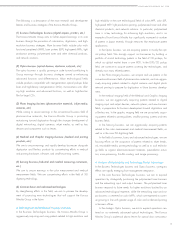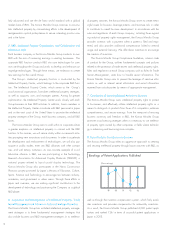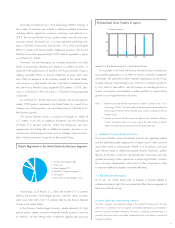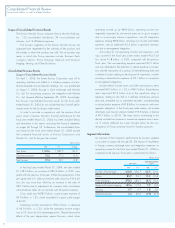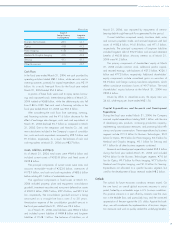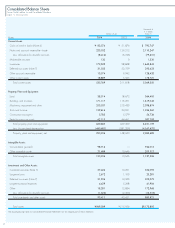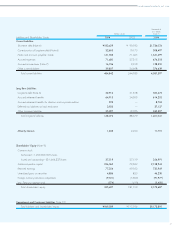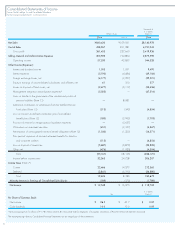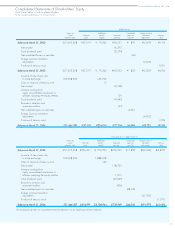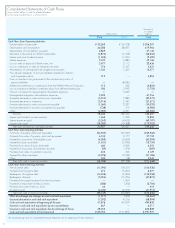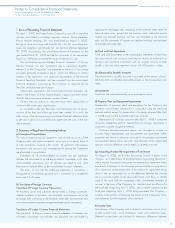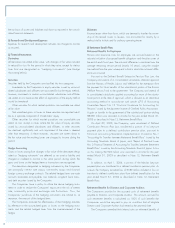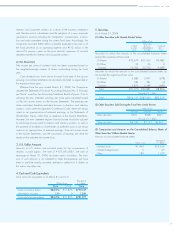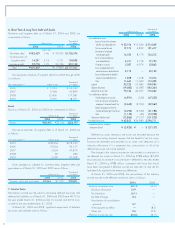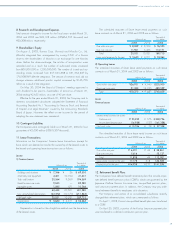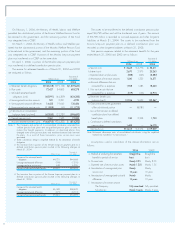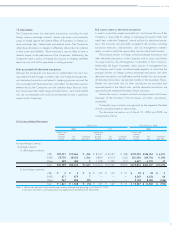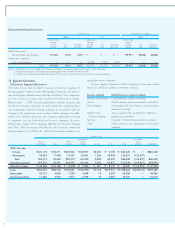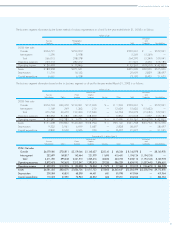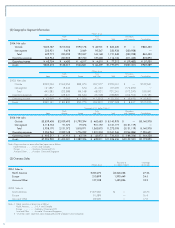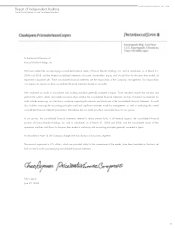Konica Minolta 2004 Annual Report Download - page 47
Download and view the complete annual report
Please find page 47 of the 2004 Konica Minolta annual report below. You can navigate through the pages in the report by either clicking on the pages listed below, or by using the keyword search tool below to find specific information within the annual report.
45
KONICA MINOLTA HOLDINGS, INC. 2004
Notes to Consolidated Financial Statements
Konica Minolta Holdings, Inc. and Consolidated Subsidiaries
For the fiscal years ended March 31, 2004 and 2003
1. Basis of Presenting Financial Statements
On April 1, 2003, the former Konica Corporation spun off its operating
activities and shifted to a holding company structure. Shortly thereafter,
Konica Minolta Holdings, Inc. was established on August 5, 2003,
through a share exchange with Minolta Co., Ltd. For accounting pur-
poses, the integration with Minolta Co., Ltd. became effective September
30, 2003. Accordingly, the consolidated financial statements for the
year ended March 31, 2003 and the first six months of the year ended
March 31, 2004 do not include the results of Minolta Co., Ltd.
The accompanying consolidated financial statements of Konica
Minolta Holdings, Inc. (the “Company”) and its subsidiaries (together,
referred to as the “Companies”) are prepared on the basis of accounting
principles generally accepted in Japan, which are different in certain
respects to the application and disclosure requirements of International
Financial Reporting Standards, and are compiled from the consolidated
financial statements prepared by the Company as required by the
Securities and Exchange Law of Japan.
Certain items presented in the consolidated financial statements sub-
mitted to the Director of Kanto Finance Bureau in Japan have been reclas-
sified for the convenience of readers outside of Japan.
Certain amounts previously reported have been reclassified to
conform to the current year classifications.
As permitted under the Securities and Exchange Law of Japan,
amounts of less than one million yen have been omitted. As a result, the
totals shown in the accompanying consolidated financial statements (both
in yen and in dollars) do not necessarily agree with the sums of the indi-
vidual amounts.
2. Summary of Significant Accounting Policies
(a) Principles of Consolidation
The consolidated financial statements include the accounts of the
Company and, with certain exceptions which are not material, those of
its 122 subsidiaries in which it has control. All significant intercompany
transactions and accounts and unrealized profits among the Companies
are eliminated in consolidation.
Investments in 14 unconsolidated subsidiaries and two significant
affiliates are accounted for by the equity method. Investments in 20 other
unconsolidated subsidiaries and 10 affiliates are stated at cost, since
they have no material effect on the consolidated financial statements.
The excess of cost over the underlying investments in subsidiaries is
recognized as consolidation goodwill and is amortized on a straight-line
basis over 5 to 20 years.
(b) Translation of Foreign Currencies
Translation of Foreign Currency Transactions
All monetary assets and liabilities denominated in foreign currencies,
whether long-term or short-term, are translated into Japanese yen at the
exchange rates prevailing at the balance sheet date and revenues and
costs are translated using the average exchange rate for the period.
Translation of Foreign Currency Financial Statements
The translations of foreign currency financial statements of overseas con-
solidated subsidiaries and affiliates into Japanese yen are made by
applying the exchange rates prevailing at the balance sheet dates for
balance sheet items, except that the common stock, additional paid-in
capital and retained earnings accounts are translated at the historical
rates and the statements of income and retained earnings are translated
at average exchange rates.
(c) Cash and Cash Equivalents
Cash and cash equivalents in the consolidated statements of cash flows
are composed of cash on hand, bank deposits able to be withdrawn on
demand and short-term investments with an original maturity of three
months or less and which represent a minor risk of fluctuation in value.
(d) Allowance for Doubtful Accounts
The allowance for doubtful accounts is provided at the amount of possi-
ble losses from uncollectible receivables based on the management’s esti-
mate.
(e) Inventories
Inventories are valued principally on an average-cost basis.
(f) Property, Plant and Equipment Depreciation
Depreciation of property, plant and equipment for the Company and
domestic consolidated subsidiaries is computed using the declining
balance method except for depreciation of buildings acquired after April
1, 1998, based on the estimated useful lives of assets.
Depreciation of buildings acquired after April 1, 1998 is computed
using the straight-line method. Depreciation for foreign subsidiaries is
computed using the straight-line method.
Ordinary maintenance and repairs are charged to income as
incurred. Major replacements and improvements are capitalized. When
properties are retired or otherwise disposed of, the property and related
accumulated depreciation accounts are relieved of the applicable
amounts and any differences are charged or credited to income.
(g) Accounting Standard for Impairment of Fixed Assets
On August 9, 2002, the Business Accounting Council in Japan issued
“Opinion on Establishment of Asset-Impairment Accounting Standards,”
which requires that certain fixed assets be reviewed for impairment when-
ever events or changes in circumstances indicate that the carrying amount
of an asset may not be recoverable. If the criterion for impairment recog-
nition is met, an impairment loss as the difference between the carrying
amount and the higher of net discounted future cash flows or market
value of the asset shall be recognized in the consolidated statement of
income. In the case of the Company, this standard shall be effective for
the fiscal years beginning April 1, 2005, with an earlier adoption for the
fiscal year beginning April 1, 2004 being permitted. The Company is
currently in the process of assessing the impact on the Companies’ finan-
cial statements from the adoption of this standard.
(h) Income Taxes
Income taxes of the Company and its domestic subsidiaries consist of cor-
porate income taxes, local inhabitants’ taxes and enterprise taxes.
Deferred income taxes are provided for temporary differences between


